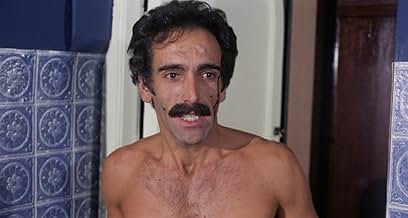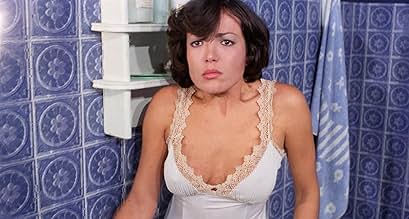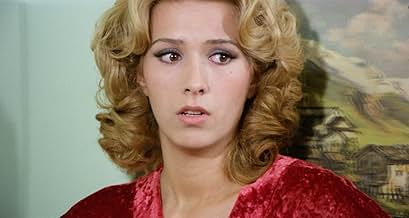CALIFICACIÓN DE IMDb
5.4/10
582
TU CALIFICACIÓN
Agrega una trama en tu idiomaA writer arrives to an isolated boardinghouse run by a beautiful but strange woman. Shortly after his arrival, guests start to get violently killed.A writer arrives to an isolated boardinghouse run by a beautiful but strange woman. Shortly after his arrival, guests start to get violently killed.A writer arrives to an isolated boardinghouse run by a beautiful but strange woman. Shortly after his arrival, guests start to get violently killed.
- Dirección
- Guionistas
- Elenco
Heinrich Starhemberg
- Daniel
- (as Henry Gregor)
Tony García Jr.
- Young Boy
- (as Tony Garcia Pablo)
León Klimovsky
- Paisano
- (sin créditos)
Opiniones destacadas
Another "Trauma"? If I put aside a dollar for (horror) movie I watched with as title - or as a.k.a. Title - "Trauma", I could at least treat myself to a lunch at McDonalds or something. It's incredibly how many movies have this title!
Anyway, this puppy is included in the fancy Blu-Ray DVD collection "Forgotten Gialli" (*), and boy does it ever belong there! It's obscure and unknown, but undeservedly so, because it features all the juicy and delicious trademarks we worship so dearly. Beautiful women, gratuitous nudity, and blood-soaked murders committed by an unseen assailant wearing black gloves and using a razorblade. The plot is thin and borrows heavily from Hitchcock's landmark "Psycho", but true Giallo-fanatics see right through that. "Trauma" is actually a Spanish Giallo, not an Italian one. Writer/director Léon Klimovsky frequently collaborated with horror icon Paul Naschy, and previously made other giallo, with "A Dragonfly for Each Corpse".
Daniel, a struggling writer with personal problems, arrives in a very remote and isolated Spanish guest house owned by the beautiful Veronica. She's often distracted by her disabled husband in the attic, but Daniel loves the place and the female owner, so he books for several nights extra. Other clients check in as well, but their stay is brutally interrupted by a vicious killer with a razor. The plot is basic and very simple to figure out, but there's enough weirdness to keep you fascinated. Although not a very handsome man, the women throw themselves at Daniel, but he seems more interested in a 14-year-old local boy. The sequence where he dries off the boy after a swim felt quite uncomfortable. All women in "Trauma" (Agatha Lys, Irene Foster, Isabel Pisano, and Sandra Alberti) are exquisite and unpretentiously show off their bodily assets.
(*) I'm probably not supposed to make publicity around here, but the "Forgotten Gialli" collection is a fantastic series! Most people know the classic gialli by acclaimed directors like Dario Argento, Mario Bava, or Sergio Martino, but this series highlights many unknown titles from equally unknown directors. "Trauma" was the only one I hadn't seen yet, but the (thus far) five volumes contain some dazzling titles, like "The Killer is one of Thirteen", "The Police Are Blundering in the Dark", "My Dear Killer", "Nine Guests for a Crime", and others.
Anyway, this puppy is included in the fancy Blu-Ray DVD collection "Forgotten Gialli" (*), and boy does it ever belong there! It's obscure and unknown, but undeservedly so, because it features all the juicy and delicious trademarks we worship so dearly. Beautiful women, gratuitous nudity, and blood-soaked murders committed by an unseen assailant wearing black gloves and using a razorblade. The plot is thin and borrows heavily from Hitchcock's landmark "Psycho", but true Giallo-fanatics see right through that. "Trauma" is actually a Spanish Giallo, not an Italian one. Writer/director Léon Klimovsky frequently collaborated with horror icon Paul Naschy, and previously made other giallo, with "A Dragonfly for Each Corpse".
Daniel, a struggling writer with personal problems, arrives in a very remote and isolated Spanish guest house owned by the beautiful Veronica. She's often distracted by her disabled husband in the attic, but Daniel loves the place and the female owner, so he books for several nights extra. Other clients check in as well, but their stay is brutally interrupted by a vicious killer with a razor. The plot is basic and very simple to figure out, but there's enough weirdness to keep you fascinated. Although not a very handsome man, the women throw themselves at Daniel, but he seems more interested in a 14-year-old local boy. The sequence where he dries off the boy after a swim felt quite uncomfortable. All women in "Trauma" (Agatha Lys, Irene Foster, Isabel Pisano, and Sandra Alberti) are exquisite and unpretentiously show off their bodily assets.
(*) I'm probably not supposed to make publicity around here, but the "Forgotten Gialli" collection is a fantastic series! Most people know the classic gialli by acclaimed directors like Dario Argento, Mario Bava, or Sergio Martino, but this series highlights many unknown titles from equally unknown directors. "Trauma" was the only one I hadn't seen yet, but the (thus far) five volumes contain some dazzling titles, like "The Killer is one of Thirteen", "The Police Are Blundering in the Dark", "My Dear Killer", "Nine Guests for a Crime", and others.
An accomplished writer arrives to a guesthouse near the lake in the middle of nowhere.Its owner is a young and obviously troubled woman.During the night a sexually active couple is slashed to death by a mysterious black-gloved killer.More savage murders follow.Who is behind them?"Trauma" by Leon Klimovsky reminded me a little bit S.F Brownrigg's underrated "Keep My Grave Open".All the killings via razor are vicious and bloody.There is plenty of sex and nudity-in fact "Trauma" is perhaps the sleaziest horror film made by Leon Klimovsky.The plot offers some genuine suspense and a bit of perversion and nasty misogyny.I enjoyed this rare and utterly forgotten slasher/giallo.8 razors out of 10.
Iolación fatal is a grim, unsettling entry in the late-70s wave of Spanish exploitation cinema, wrapped in the aesthetics of a psychological thriller but weighed down by uneven execution. While the film touches on disturbing themes and presents a few stylistic flourishes, it struggles to rise above the genre's more gratuitous tendencies.
Atmospherically, the film succeeds in creating a sense of dread. The lighting is often stark and moody, particularly in interior scenes where shadows feel like silent observers. Cinematographer Francisco Sánchez captures a creeping tension in narrow hallways and dimly lit bedrooms, often allowing the frame to linger just long enough to unsettle. Yet, this stylistic care doesn't always carry through. Some scenes fall flat visually, with pedestrian compositions or abrupt edits that undercut their emotional weight. There's a disconnect between the visual intent and the rhythm of the narrative, which makes the film feel choppy at times.
Performance-wise, the cast handles the material with varying degrees of conviction. Ágata Lys delivers a haunting and layered performance, striking a delicate balance between vulnerability and restrained strength. Her presence anchors the film, elevating scenes that might have otherwise veered into exploitation without nuance. In contrast, some supporting actors fall into melodrama, lacking the subtlety the script seems to call for. Still, even with these inconsistencies, there's a raw sincerity in several exchanges that makes the human drama feel real, if not always well-paced.
The film's major flaw lies in its tendency toward sensationalism. At points, it leans heavily on nudity and lurid scenarios to provoke rather than explore. This often blunts the psychological depth the film flirts with, leaving some scenes feeling gratuitous instead of essential. There's an undercurrent of commentary about trauma and guilt, but it never fully matures into something cohesive. Instead, the movie circles its themes, hesitant to confront them head-on.
In the end, Violación fatal is a mixed bag. It has moments of genuine tension and some striking visual choices, but it lacks the narrative focus and restraint to elevate its subject matter. Ágata Lys's performance remains the most memorable element, a compelling center in a film that too often drifts toward exploitation without clear purpose.
Atmospherically, the film succeeds in creating a sense of dread. The lighting is often stark and moody, particularly in interior scenes where shadows feel like silent observers. Cinematographer Francisco Sánchez captures a creeping tension in narrow hallways and dimly lit bedrooms, often allowing the frame to linger just long enough to unsettle. Yet, this stylistic care doesn't always carry through. Some scenes fall flat visually, with pedestrian compositions or abrupt edits that undercut their emotional weight. There's a disconnect between the visual intent and the rhythm of the narrative, which makes the film feel choppy at times.
Performance-wise, the cast handles the material with varying degrees of conviction. Ágata Lys delivers a haunting and layered performance, striking a delicate balance between vulnerability and restrained strength. Her presence anchors the film, elevating scenes that might have otherwise veered into exploitation without nuance. In contrast, some supporting actors fall into melodrama, lacking the subtlety the script seems to call for. Still, even with these inconsistencies, there's a raw sincerity in several exchanges that makes the human drama feel real, if not always well-paced.
The film's major flaw lies in its tendency toward sensationalism. At points, it leans heavily on nudity and lurid scenarios to provoke rather than explore. This often blunts the psychological depth the film flirts with, leaving some scenes feeling gratuitous instead of essential. There's an undercurrent of commentary about trauma and guilt, but it never fully matures into something cohesive. Instead, the movie circles its themes, hesitant to confront them head-on.
In the end, Violación fatal is a mixed bag. It has moments of genuine tension and some striking visual choices, but it lacks the narrative focus and restraint to elevate its subject matter. Ágata Lys's performance remains the most memorable element, a compelling center in a film that too often drifts toward exploitation without clear purpose.
Trauma is very similar to Alfred Hitchcock's Psycho in that we're given an outsider who shows up to a strange secluded hotel where the owner has a big secret and people are getting murdered. For a European horror film, it's low on style and gore and feels more like a cheapo exploitation film from the U. S. around that time. There's not enough insanity to make it a worthwhile watch except for completeists.
A writer stops off at a secluded bed and breakfast run by the battered wife of a mysterious man who spends all his time upstairs in his room. That is except when he's killing off the lodgers downstairs.
If you've seen more than 3 horror movies in your lifetime, the big twists in Trauma won't come as any big surprise, but it's not the worst film of its type and it keeps things entertaining. It features a lot more sexuality than expected with just about everyone in the film getting naked and having sex at some point. The gore effects are of the cheap variety with some razor slashes that don't completely convince.
If you've seen more than 3 horror movies in your lifetime, the big twists in Trauma won't come as any big surprise, but it's not the worst film of its type and it keeps things entertaining. It features a lot more sexuality than expected with just about everyone in the film getting naked and having sex at some point. The gore effects are of the cheap variety with some razor slashes that don't completely convince.
¿Sabías que…?
- TriviaHeinrich Starhemberg (aka Henry Gregor), as Daniel, is also the movie's executive producer.
- ErroresWhen Daniel Meets Veronica for the first time, she accidentally drops a wine bottle on the floor smashing it. in the next shot the broken bottle and the spilled wine are not seen.
- Créditos curiososThe closing credits appear on a still photography of one of the characters.
- ConexionesReferences El lobo humano (1941)
Selecciones populares
Inicia sesión para calificar y agrega a la lista de videos para obtener recomendaciones personalizadas
- How long is Trauma?Con tecnología de Alexa
Detalles
- Tiempo de ejecución1 hora 27 minutos
- Mezcla de sonido
- Relación de aspecto
- 1.85 : 1
Contribuir a esta página
Sugiere una edición o agrega el contenido que falta

Principales brechas de datos
By what name was Trauma (1978) officially released in India in English?
Responda

























